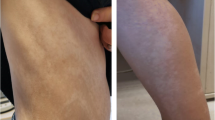Abstract
There is an ample evidence that hypopigmentation of the skin along the Blaschko’s lines is frequently associated with neurological disorders. Nowadays, the term “Hypomelanosis of Ito” (HI) is applied when, together with the cutaneous lesions, various and multisystem organs are involved. Among these, the most frequent are cerebral manifestations, such as cognitive delay and epileptic seizures. For this reason, hypomelanosis of Ito has been included in the group of neurocutaneous syndromes, neurologic manifestations being one of the most frequent. Epileptic seizures have been reported in patients with this disorder, but in a very few particular attention has been focused on the type and frequency of epilepsy and on the response to the treatment. Herein, we report on five patients with HI who showed episodes of epileptic seizures with onset in childhood, in absence of malformative anomalies except for the skin lesions. A survey on the frequency and types of epileptic seizures in HI children and in the literature is reported.





Similar content being viewed by others
References
Happle R (1993) Mosaicism in human skin. Understanding the patterns and mechanisms. Arch Dermatol 129:1460–1470
Happle R (1998) Incontinentia pigmenti versus hypomelanosis of Ito: the whys and wherefores of a confusing issue. Am J Med Genet 79:64–65
Ito M (1952) Studies of melanin XI. Incontinentia pigmenti achromians: a singular case of nevus depigmentosus systematicus bilateralis. Tohoku Exper Med 55(suppl):57–59
Sybert VP (1994) Hypomelanosis of Ito: a description, not a diagnosis. J Invest Dermatol 103:141S–143S
Taibjee SM, Bennett DC, Moss C (2004) Abnormal pigmentation in hypomelanosis of Ito and pigmentary mosaicism: the role of pigmentary genes. B J Dermatol 151:269–282
Ruggieri M, Pavone L (2000) Hypomelanosis of Ito: clinical syndrome or just phenotype? J Child Neurol 15:635–644
Küster W, König A (1999) Hypomelanosis of Ito: no entity, but a cutaneous sign of mosaicism. Am J Med Genet 85:346–350
Jelinek JE, Bart RS, Shiff GM (1973) Hypomelanosis of Ito (“Incontinentia pigmenti achromians”). Arch Dermatol 107:596–601
Pascual-Castroviejo I, Lopez Martin V, Tendero A, Martinez Bermejo A, Lopez-Terradas JM, Roche C et al (1989) Epidemiología y experiencia personal de los trastornos neuroectodérmicos. In: Pascual-Castroviejo I (ed) Trastornos Neuroectodérmicos. JR Prous, Barcelona, pp 1–71
Ruiz-Maldonado R, Toussaint S, Tamayo L, Laterza A, del Castillo V (1992) Hypomelanosis of Ito: diagnostic criteria and report of 41 cases. Pediat Dermatol 9:1–10
Zappella M (1993) Autism and hypomelanosis of Ito in twins. Develop Med Child Neurol 35:826–832
Hara M, Kozasa M, Mituisi Y, Yajima K, Saito K, Fukuyama Y (1989) Ito syndrome (Hypomelanosis of Ito) as a cause of intractable epilepsy. In: Pascual-Castroviejo I (ed) Trastornos Neuroectodérmicos. JR Prous, Barcelona, pp 221–225
Nehal KS, Pe Benito R, Orlow SJ (1996) Analysis of 54 cases of hypopigmentation and hyperpigmentation along the lines of Blaschko. Arch Dermatol 132:1167–1170
Ruggieri M (2000) Familial hypomelanosis of Ito: implications for genetic counseling. Am J Med Genet 95:82–84
Edelstein S, Naidich TP, Newton TH (2004) The rare phakomatoses. Neuroimaging Clin N Am 14:185-217, vii
Ruggieri M, Tizano G, Mazzone D, Tiné A, Pavone L (1996) Involvement of the white matter in hypomelanosis of Ito (incontinentia pigmenti achromiens). Neurology 46:485–492
Ross DL, Liwnicz BH, Chun RWM, Gilbert E (1982) Hypomelanosis of Ito (incontinentia pigmenti achromians)—a clinicopathologic study: macrocephaly and gray matter heterotopias. Neurology 32:1013–1016
Turleau C, Taillard F, Doussau de Bezignan M, Delépine N, Desbois JC, de Grouchy J (1984) Hypomelanosis of Ito (incontinentia pigmenti achromians) and mosaicism for a microdeletion of 15 q1. Hum Genet 74:185–187
Ardinger HH, Bell WE (1986) Hypomelanosis of Ito Wood’s light and magnetic resonance imaging as diagnostic measures. Arch Neurol 43:848–850
Malherbe V, Pariente D, Tardieu M, Lacroix C, Venencie PY, Hibon D et al (1993) Central nervous system lesions in hypomelanosis of Ito: an MRI and pathological study. J Neurol 240:302–304
Ono J, Harada K, Kodaka R, Ishida M, Okada S (1997) Regional cortical dysplasia associated with suspected hypomelanosis of Ito. Pediatr Neurol 17:252–254
Schwartz MF, Esterly NB, Fretzin DF, Pergament E, Rozenfeld IH (1977) Hypomelanosis of Ito (incontinentia pigmenti achromians): a neurocutaneous syndrome. J Pediatr 90:236–240
Fleury P, Dingemans K, de Groot WP, Oranje AP, Voûte PA, Woerdeman MJ et al (1986) Ito’s hypomelanosis (incontinentia pigmenti achromians). A review of four cases. Clin Neurol Neurosurg 88:39–44
Glover MT, Brett EM, Atherton DJ (1989) Hypomelanosis of Ito: spectrum of the disease. J Pediatr 115:75–80
Esquivel EE, Pitt MC, Boyd SG (1991) EEG findings in hypomelanosis of Ito. Neuropediatrics 22:216–219
Steiner J, Adamsbaum C, Desguerres I, Lalande G, Raynaud F, Ponsot G (1996) Hypomelanosis of Ito and brain abnormalities: MRI findings and literature review. Pediatr Radiol 26:763–768
Pascual-Castroviejo I, Roche MC, Martinez Fernandez V, Pérez-Romero M, Escudero RM, Garcia-Peñas JJ et al (1994) Incontinentia pigmenti: MR demonstration of brain changes. Am J Neuroradiol 115:1521–1527
Ruggieri V, Granama N, Palacios C (1998) Nervous system involvement in 30 children with Hypomelanosis of Ito. Brain Dev 20:372
Pavone L, Ruggieri M, Spalice A, Pavone P, Savasta S, Iannetti P (2006) “Hypomelanosis of Ito”. In: Curatolo P, Riva D (eds) Neurocutaneous Syndromes in children, John Libbey Eurotext, pp. 25-32
Assogba K, Ferlazzo E, Striano P, Calarese T, Villeneuve N, Ivanov I et al (2010) Heterogeneous seizure manifestations in Hypomelanosis of Ito: report of four new cases and review of the literature. Neurol Sci 31:9–16
Acknowledgments
The authors wish to thank Prof. Mike Wilkinson who assisted in the proof-reading of the manuscript.
Conflict of interest
The authors have no financial disclosures or conflicts of interest to declare concerning this manuscript.
Author information
Authors and Affiliations
Corresponding author
Rights and permissions
About this article
Cite this article
Pavone, P., Praticò, A.D., Ruggieri, M. et al. Hypomelanosis of Ito: a round on the frequency and type of epileptic complications. Neurol Sci 36, 1173–1180 (2015). https://doi.org/10.1007/s10072-014-2049-1
Received:
Accepted:
Published:
Issue Date:
DOI: https://doi.org/10.1007/s10072-014-2049-1




